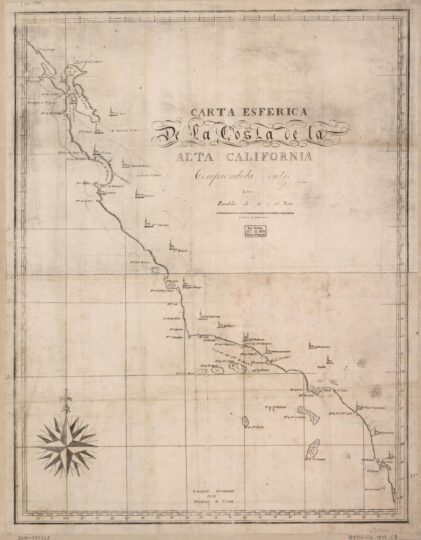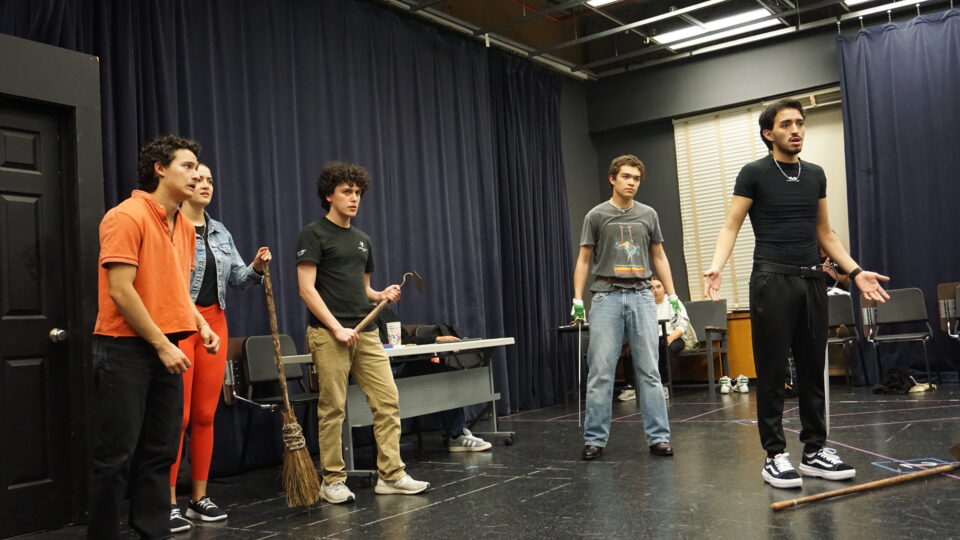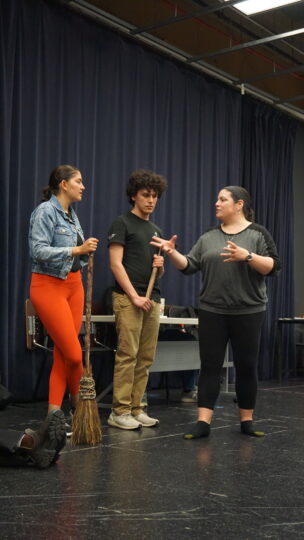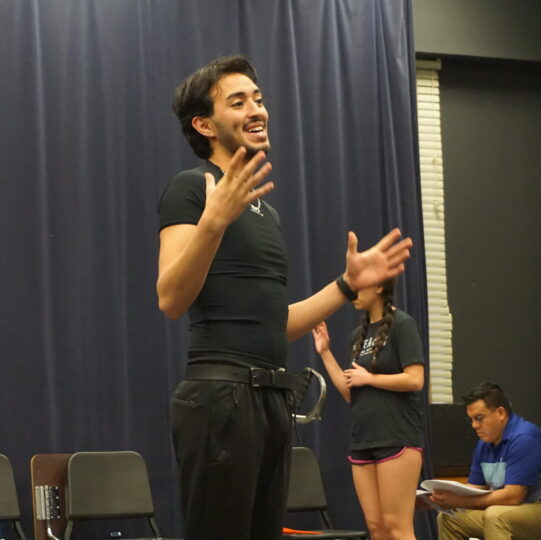Dramaturg Demian Chavez Galvan digs into the script and context for Romeo y Juliet, from the new setting to working with a group of predominantly Latino artists to realize this bilingual production. Read their article in English or scroll down for their full article in Spanish.
When KJ Sanchez and Karen Zacarías first explored the concept of a bilingual adaptation of Romeo and Juliet, they knew they needed to place the action in a setting that felt like a pressure cooker. It was vital that the audience feel that the characters act in the only way they could given their circumstances. Five people will die by the time the play is over, and we need to believe each of their deaths is tragically inevitable.

They found their setting in Alta California, a province of New Spain annexed by the United States following the signing of the Treaty of Guadalupe Hidalgo in 1848, which formally ended the Mexican-American War. Mexico was made to cede over five hundred thousand square miles of land, including present-day California, Nevada, Utah and portions of Colorado, New Mexico, Arizona and Wyoming. This new land became the American frontier, fulfilling the promise of Manifest Destiny and extending the borders of the United States from coast to coast.
This history informs the setting and cultural context of this adaptation, but likewise, it heavily informs our present; Austin sits squarely within disputed territory in Texas that was relinquished by Mexico as part of the Treaty of Guadalupe Hidalgo. The border, as we know it in Texas, was drawn in 1848. From this, the famous adage was born: “We didn’t cross the border, the border crossed us.”
Latinos have been in Texas for centuries, long before this land became part of the United States of America. Latinos fought for Mexican independence from Spain, Texan independence from Mexico and on both sides of the Mexican-American War. We have liberated, populated and cultivated this land; this land is ours.

This reality was further cemented in 2021 when Latinos became the most populous ethnic group in Texas. As of 2021, two out of every five Texans identifies as Latino. That number is even higher for the underage population – nearly half of Texans under the age of eighteen identify as Latino. This is a state with rich Latino roots and an even richer Latino future.

The University of Texas at Austin, as the flagship public school of the state of Texas, exemplifies this rich future. In 2020, UT Austin was recognized as a Hispanic Serving Institution, a designation granted by the Department of Education to higher education institutions with twenty-five percent or higher Latino enrollment. As of fall 2023, over thirteen-thousand of UT’s nearly fifty-two-thousand students identify as Latino. We can be found in every school and college, from the McCombs School of Business to the Moody College of Communication and, of course, in the College of Fine Arts and the Department of Theatre and Dance.
This department has a rich history of uplifting the work of Latino theatremakers. In the past decade, productions of Esperanza Rising, Luna, The Hero Twins: Blood Race, La Ruta, del corazón nace el enjambre and The Smartest Girl in the World have graced Winship stages. KJ Sanchez and Karen Zacarías’ Romeo y Juliet is the latest in this tradition of theatremaking that uplifts the work of Latino artists – not just those that wrote the text of the play but, importantly, those that have worked to bring the play to life.

I have had the great fortune to work as part of a company of predominantly Latino artists to bring Romeo y Juliet to the Oscar G. Brockett Theatre. For these artists, Romeo y Juliet has presented the chance to proudly reaffirm their identity and uplift their heritage in a setting that puts it on the same level as William Shakespeare’s work. It’s not often that we get to hear the poetry of Latina dramatists alongside the words of the Bard.
As we near our opening on April 10, I find myself thinking about the audiences who will get to experience this work. I think of Austin’s Latino population, but I especially think of the families of cast members. I think of the mamás and papás, of abuelas and hermanitos and tias and primos, those that were there for our high school productions of The Crucible or summer stock productions of Grease. This play belongs to the company, yes, but so too does it belong to the audience; this is our land, and this our theatre.
Written by Demian Chavez Galvan.
Rehearsal photos by Amber Huchton.
Romeo y Juliet
April 10-21, 2024
Oscar G. Brockett Theatre
TICKETS
El dramaturgo Demian Chavez Galvan escribe sobre el guión y contexto de Romeo y Juliet, desde el nuevo contexto histórico de la obra hasta el trabajo con una compañía de artistas predominantemente latinos para realizar esta producción bilingüe:
NUESTRA TIERRA, NUESTRO TEATRO:
AFIRMANDO LATINIDAD EN LOS ESCENARIOS DE WINSHIP
Cuando KJ Sánchez y Karen Zacarías exploraron por primera vez el concepto de una adaptación bilingüe de Romeo y Julieta, sabían que necesitaban ubicar la acción en un lugar que se sintiera como una olla de presión. Era necesario que el público sintiera que los personajes actúan de la única manera que podrían hacerlo dadas sus circunstancias. Cinco personas morirán cuando termine la obra y debemos creer que cada una de sus muertes es trágicamente inevitable.

Encontraron su lugar en Alta California, una provincia de Nueva España anexada por los Estados Unidos tras la firma del Tratado de Guadalupe Hidalgo en 1848, cual puso fin a la guerra entre México y los Estados Unidos. México fue obligado a ceder más de quinientas mil millas cuadradas de su terreno, incluidas las actuales California, Nevada, Utah y partes de Colorado, Nuevo México, Arizona y Wyoming. Esta nueva tierra se convirtió en la frontera americana, cumpliendo la promesa del Destino Manifiesto y extendiendo las fronteras de los Estados Unidos del Atlántico hasta el Pacifico.
Esta historia informa el entorno y el contexto cultural de esta adaptación, pero también informa en gran medida nuestro presente; Austin se encuentra directamente dentro del territorio en Texas que fue abandonado por México como parte del Tratado de Guadalupe Hidalgo. La frontera, tal como la conocemos en Texas, se trazó en 1848. De ahí nació el famoso dicho: “No cruzamos la frontera, la frontera nos cruzó a nosotros”.
Los latinos han estado en Texas por siglos, mucho antes de que esta tierra se convirtiera en estadounidense. Los latinos lucharon por la independencia de México de España, la independencia de Texas de México, y en ambos lados de la guerra entre México y los Estados Unidos. Hemos liberado, poblado, y cultivado esta tierra; esta tierra es nuestra.

Esta realidad se consolidó aún más en el 2021, cuando los latinos se convirtieron en el grupo étnico más grande de Texas. A partir del 2021, dos de cada cinco tejanos se identifican como latinos. Ese número es aún mayor para la población menor de edad: casi la mitad de los texanos menores de dieciocho años se identifican como latinos. Este es un estado con raíces latinas y un futuro latino.

La Universidad de Texas en Austin, como la escuela pública emblemática del Estado de Texas, ejemplifica este futuro. En el 2020, UT Austin fue reconocida como una Institución al Servicio de Hispanos, una designación otorgada por el Departamento de Educación a instituciones de educación alta con veinticinco por ciento o más de inscripción latina. A partir del otoño del 2023, más de trece mil de los casi cincuenta yndos mil estudiantes de UT se identifican como latinos. Nos pueden encontrar en todas las esquinas de esta universidad, desde la Escuela de Negocios McCombs hasta el Colegio de Comunicaciones Moody y, por supuesto, en la Facultad de Bellas Artes y el Departamento de Teatro y Danza.
Este departamento tiene una rica historia de enaltecer el trabajo de artistas de teatro latinos. En la última década, producciones de Esperanza Rising, Luna, Los Gemelos Héroes: Carrera de Sangre, La Ruta, del corazón nace el enjambre, y La Niña Mas Inteligente del Mundo han aparecido en los escenarios de Winship. Romeo y Julieta, de KJ Sánchez y Karen Zacarías, es la última en esta tradición de creación teatral que eleva el trabajo de los artistas latinos, no solo aquellos que escribieron el texto de la obra, sino, más importante aún, aquellos que han trabajado para darle vida a la obra.

He tenido la gran fortuna de trabajar como parte de una compañía de artistas predominantemente latinos para traer Romeo y Julieta al escenario Brockett. Para estos artistas, Romeo y Julieta ha presentado la oportunidad de reafirmar con orgullo su identidad y realzar su herencia en un entorno que la sitúa al mismo nivel que las obras de William Shakespeare. No es frecuente que escuchemos la poesía de dramaturgas latinas junto con las palabras del tal-llamado Bardo de Stratford-Upon-Avon.
A medida que nos acercamos a nuestro estreno el 10 de abril, pienso en el público que podrá ver esta obra. Pienso en la población latina de Austin, pero pienso especialmente en las familias de los miembros del elenco. Pienso en las mamás y los papás, en las abuelas, los hermanitos, las tías y los primos, aquellos que estuvieron allí para nuestras producciones de secundaria de El Crisol o las producciones de verano de Grease. Esta obra es de la compañía, sí, pero también del público; esta es nuestra tierra y este nuestro teatro.
Escrito por Demian Chavez Galvan.
Romeo y Juliet
10-21 de abril de 2024
Teatro Oscar G. Brockett
BOLETOS

